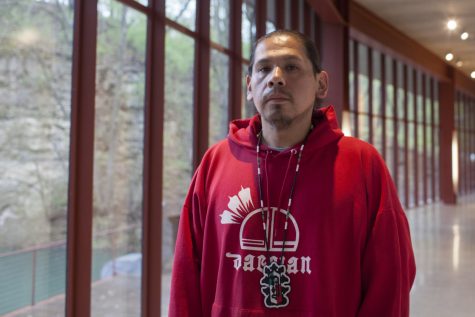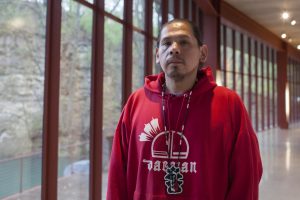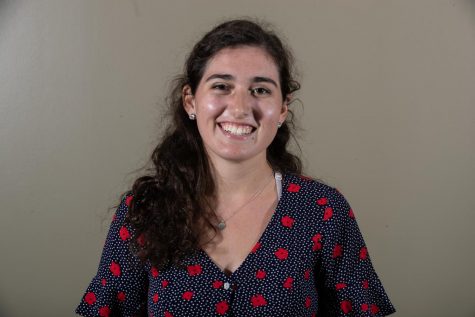Q&A: UI President Bruce Harreld talks tuition, Modern Piping dispute, future at UI
University of Iowa President Bruce Harreld sat down with The Daily Iowan on May 2 to discuss the diversity, equity, and inclusion plan, the Modern Piping dispute, and tuition for the next academic year.
University of Iowa President Bruce Harreld sits down for an interview with the Daily Iowan in the Adler Journalism Building on May 2, 2019.
May 5, 2019
UI President Bruce Harreld: This is a special time on campus. We’ve got what, 5,280 graduates going through the process the next few days. It’ll start on Thursday night and end probably on Monday. Usually, the last one is engineering.
I think one of the amazing things about that cohort is not just the size, but also one fifth of them are first-generation students. We’ve put a real focus on that, we keep talking about it. … I think it’s in the press, that we got the NASPA, the student affairs professionals recognized us and asked us to come to national forum to talk about what we’re doing to support first-generation students. I think that’s quite an honor, but I think more importantly, we’ll actually learn what others are doing, and maybe be able to bring some of those ideas back to campus. So, I just wanted to start with a little bit of good news before we get into some of the other issues.
The Daily Iowan: To start out with a lighthearted question, we did our research outside Jessup Hall, our DI films team, to see if students knew you. Did you see those results and what did you think?
RELATED: Student Thoughts Episode 2: Can you identify UI President Bruce Harreld?
Harreld: I saw students’ comments, yes and no, and what have you. What were the final statistics?
DI: We decided that it was 50/50 — people knew you, people didn’t know you.
Harreld: I think it’s a real shame that half don’t, and I’d like to get to know them better. So if you don’t know me, come forward and let’s talk, or give me your name and I’ll find you. Last time, I told you I didn’t know if it was going to be high or low, if you remember, and here we are, we still don’t know whether it’s high or low. It’s 50/50.
DI: Some new administrators have been hired recently — the Associate Vice President for Diversity, Equity, and Inclusion and the Vice President for Research — and those are some areas in particular where there’s been some shifts in the functions of those offices. What do you think the importance will be of having those new administrators?
Harreld: We’ve got three new senior administrators in the system, and you’re right, I think we still have work to do in actually all three of those. Keep in mind in research we split economic development and support for startups away from research, and so we now have Jon Darsee who’s building a network or capabilities to support our startups, to take the intellectual property that gets produced on this campus, which is pretty massive, and turn it into viable startups. We can talk about all the support mechanisms we need to build to help those startups, and he’s actually reaching beyond just this region and going to Silicon Valley, trying to get those players engaged. We were actually in Ames a couple weeks ago, talking to the Ames Seed Capital group that has very active community funding the needs of startup groups. John’s up and running, and then we’ve now completed almost a year long search for research.
I think the key issue in research has been there are a lot of issues of making sure we abide by rules and regulations at state and federal levels with the research. Some of that is around human subjects, some of that’s around the care of mice and other animals we use for testing and research, and that will always be the case. What my hope is, and Martin Scholtz was hired with the expectation, that we need to build a support mechanisms underneath our researchers like I was describing for economic development. So, rather just tell them what they have to do or what they can’t do and setting rules and regulations, what we need to do is build and make sure we have the laboratories, the equipment that they need to continuing pushing science. We also need to probably help them write some of their grants so to lift them out of the administrative workload. We need to make it easier to deal with some of the human and animal testing policies and simplification so researchers don’t have to be administrators.
RELATED: UI names J. Martin Scholtz as new vice president for Research
I think we have a lot of work to do in that area and DEI. I think we’ve all seen, and I really would applaud, we’ve backed up, surveyed campus, found where the real issues are. I think we knew them but now we have data, and at the same put out a fairly aggressive set of action plans around that. Interestingly enough, while all that was going on, we were also recruiting somebody to lead, and that was an interesting process, because typically you have things all buttoned up, and then you do the recruiting for a leader. In this particular case, we had three people come to campus as we’re doing that. So in a sense, they could see it and shape it and actually own it. So I think TaJuan is going to hit the ground pretty aggressively here. He’s also probably the most action-oriented of the candidates we looked at, so he’s going to have a lot to do but I think he likes doing a lot. I’m really pleased with his personality and I think a lot of us are. We’ve got a lot to do.
I think one of the key things in that search is that we backed up and re-thought about is this the Chief Diversity Office, or we want to broaden the scope, and that’s where we added equity and inclusion. I think that’s ever so appropriate for us, and I think we have a tendency to say that human resource issues are part of human resources, or ethical and legal issues are part of the general counsel’s office, or diversity issues are taken care of by the Chief Diversity Office. I’m really, and I know that TaJuan really emphasized this a lot, that this isn’t really about their doing all that work in diversity, equity, and inclusion on our behalf, it’s about their creating an environment where they engage us, motivate us, support us, and actually measure how supportive we are as a community. We have work to do, and I think we know that. Here we are, it’s going to be fun.
RELATED: Wilson named new University of Iowa associate VP for diversity, equity, and inclusion
DI: With the [Diversity, Equity, and Inclusion] action plan, how do you see that taking the university where it aspires to be with the paradigm shift?
Harreld: First of all, I think there’s two dimensions of this problem simply put. One is the metrics. We don’t have enough people of all sorts of minority groups in our midst. Part of that is we don’t have that kind of adequate in our staff, our faculty doesn’t have nearly enough representation, and our student body doesn’t have nearly enough representation. So we’ve got to make it better, broader slates in our recruiting pools and our search pools. It’s almost a chicken and egg. I think I’ve sent a fair amount of time with the faculty that the more diverse our faculty is, the more likely the students will see their mentors in the group, so we’ve got to work from both ends of that. But that’s just the metrics, I think a bigger set, and you’ll see in the action plan a whole series of specific metrics that we’ll be using.
I’m much more interested in shifting our culture, and culture I think is a much more powerful tool for this. In culture, first of all we should understand the more diverse we are, the better the conversations, the more innovative the teams are, so the more diverse we are as a community, in many ways, the better we’ll do against our entire strategic agenda. I think there’s a lot of data that suggests when there are teams all composed of people like themselves, they go to sleep, they don’t have nearly as much good of filters, so I would hope that over time we start recognizing diversity isn’t just the right thing to do, it is also the smart thing to do because it builds a broader base for creativity and innovation. I think that’ll take a while, but I think it starts with me and my management team, and I think it starts with us insisting that we have diverse candidate pools. We’ve got a lot to do, it’s an important issue.
RELATED: UI unveils Diversity, Equity, and Inclusion Action Plan
DI: The state Legislature has signed off an another $12 million increase for the regent universities. That’s not quite the full $18 million that was requested, but what are your thoughts on the state funding outlook for fiscal 2020?
Harreld: I think we have been de-appropriated fairly consistently for a long period of time, and I think most of us believe that trend will continue. So whenever we get a year like this year where we get any money positively coming to us, we want to be ecstatic, and we should and say thank you. On the other hand, the problem is still with us. This state is disinvesting, even this year in my book, from public higher education. It’s a shame.
RELATED: Iowa Senate passes $12 million funding boost for regents, falling below request
I think at the end of the day, I think our state politicians see other issues way ahead of funding out regent institutions. They see K-12, they see medical mental health infrastructure, way ahead of funding for our public institutions. Even in a year when the governor asks for a lot for us, the Legislature slashes it and takes it down. So I’m thankful for whatever they do, but I don’t think our answers are going to be in the state Legislature, I really don’t. Then that leads to the nasty conversation, particularly for students and their families. They’re already aware of it, of what’s going to happen in the longer term to tuition – it has to go up. The question is, can we go up in a predictable way and a manageable way that people can anticipate, that doesn’t have huge bites out of their pocketbooks, and maybe that’s not even enough and hence we get into the whole public-private partnership.
This institution wants to soar, and not just at a national level, but an international level. We have great talent here. But our answer isn’t continual disinvestment from the state, or tuition increases that don’t cover fully, the disinvestment from the state. Our answer’s got to be something much more aggressive. I’m hopeful that maybe we’ll be able to get that done. If we don’t we’re going to have big issues.
DI: Yesterday, in speaking to the regents, students raised some concerns about the effects of the tuition increases and also the focus of the tuition model on resident undergraduate tuition alone versus graduate, nonresident tuition. So what was your response to their concerns?
RELATED: University of Iowa leaders ask regents to consider effect of tuition hikes
Harreld: I agree with them. I understand and I think it’s a tough dynamic, I mean I think in where Dexter [Golinghorst, Graduate and Professional Student Government president] was going — a very good friend I have a lot of respect for him — which is making national comparisons, is getting tired for him. But I’m going to make a national comparison. Our tuition is still incredibly low, relative to our peer group, we’re a fantastic deal. If we get on another national list of being the best valued, we see a lot of those. I want to cry because at the same time we don’t have enough funding to do all of the things that our students need and demand. He made a couple of good arguments, Dexter in particular, that point as well as the issue of more transparency and where’s the money really going to go, and how’s it really going to get spent from graduation and professional schools to really improve some of the key things.
I think [on] accountability, transparency, he’s dead on, and we need to provide more and more of that through our graduate schools. As low as our in-state tuition is, it’s an issue for us, because just do the math. We had three years of tuition freezes, and we’re still struggling to make that freeze period up. I think that was a very mistaken policy, because it’s very hard to catch up. But I do agree with him, I will accept the challenge. But the numbers are the numbers, and you’ve got to keep in mind, I will say it here but I didn’t want to go fully into it yesterday, but we’re dropping in some of the rankings. So the question becomes, a decade from now or two decades from now, what’s the value of your degree 20 years from now on your CV? If we continue to go down, as we have, it’s a shame. I think that matters, but I don’t think we should chase the rankings. I think there are flaws in them.
On the other hand, directionally, we know we have gaps in terms of student support and mentoring, and even student financial aid. We can’t get at it. We have gaps in research. With these needs, the question for the state is, what level do you want the University of Iowa to compete at? Do you want it to compete with North Carolina? Compete with UCLA? I think we can do it, but we can’t compete with North Carolina when they get a couple million dollars more from their state Legislature every year then we get, and by the way they have 5,000 fewer students. We want our cake and ate it too. And I got it, but that ain’t going to happen.
RELATED: UI president: Public/private partnership could fill funding gap
I think we need to work together as a team. I think one of the things that happened years ago is tuition was one set of issues and state appropriations was another set of issues. No one ever really combined them and put the math together. I think what the regents have done is a wonderful job of putting in a five year plan that says we will set tuition based on what the state appropriations are. You go first, and then we’ll set tuition, and I think that connection is really wise and they’ve also put a floor on it and a ceiling on it. I think the ceiling hopefully gives people some ability to plan.
DI: So the UI has come a bit closer to fully settling the Modern Piping lawsuits. The UI now only owes for the Children’s Hospital portion of the arbitration award. But the UI contends the as-builts for the hospital are needed, and it seems neither side agrees on whether everyone’s even talking about the same documents, whether they’re shop drawings or as-builts. What have your thoughts been on this more recent development in the ongoing dispute?
Harreld: Just to put a levity into this, would you believe that you would ever start understanding the difference between shop drawings and as-builts? We are all going through it. I beg to disagree with the premise of your question. I think we know exactly where we are. The contract says, and I’ll just take Hancher. Modern Piping worked on Hancher. The contract with Modern Piping on Hancher said when you provide the documents of the work you actually did, not the original design — but what you actually did on job site — when you provide those drawings, the so-called “as-builts,” to Heery International — or in that case, for Hancher, it was OPN, another architectural firm — you provide those drawings, they certify that those are detailed as-builts from the timestamp of what you did on each day — then we will pay you. That’s the way the contract read on Hancher. It just turns out that instead of OPN, it is now Heery International — same contract — and we have said continually that’s the process, and when Heery International certifies they have them, we will release the money.
Now, it turns out Heery International has said that they do not have them and we have that from multiple authorities in writing, verbally. And then I continue to hear from Modern Piping that they have them, and fine. Just give them to Heery. Let Heery finish the process. And so I don’t know where we are. Does Modern Piping really have them? Or do they have something else? I don’t know. And you probably saw earlier in the week we took the step of actually putting the money. They say well, we don’t have the money and they’re going to go get the Mural [painting by Jackson Pollock] in South Carolina and seize it. Well, we have actually put $13 million into the attorney’s trust account.
RELATED: UI, Modern Piping continue dispute over Children’s Hospital records
And the release of that money out of that trust account is pretty simple. Heery certifies that they have the drawings, and the money goes instantly. The issue is getting pretty simple here — do they or don’t they have them? If they have them, we can — I can solve this in five minutes as long as Heery says they have it. This is not about our certifying what we have or we don’t have — by the way, we don’t have anything. I hear people say well, we have, they’ve delivered. Best I can see, the hospital doesn’t have them. Project financial management team doesn’t have them. So, what’s the issue? Do they exist? … Because they also say just go into the database, so-called iBuild, and download the documents. Earlier in the week I asked, “What’s up there?” The last time data was put in there was Nov. 22, 2017. When Heery looked at those documents, they did not see the details necessary to confirm and certify that they were as-builts. And by the way, the contract says they’re supposed to deliver them on paper, not for us to download them from a database. So we have I think a group of people that may not have read the contract, or have some other notion of what the words are in that. I don’t know. I can’t make it any simpler.
DI: Do you anticipate the university would have to take further legal action to obtain the as-builts?
Harreld: Well, I’m beginning to think that they may not exist. Any reasonable person would start asking that question at this stage. Here we are with a fairly sophisticated, complex structure that has operational issues every day within it, just the way all buildings do. And we have people that need to go in and know what’s behind the walls with not only water and effluent, but also oxygen and other gases. It’s a medical hospital. And we have had a couple of minor instances we’ve been able to respond to pretty quickly, but you always kind of wonder what’s behind that wall?
So what we’re now exploring is actually asking a third party to tell us how much it would take to create, from scratch, as-builts. See the point? So, here’s a wall — what’s behind the wall? Where are the pipes? What’s in the pipe? Where are the valves? We’re figuring out how to close, if in an emergency we had to close things, we need to know what’s back there. The fire marshal needs this information.
We’re beginning to ask — do we have to go do this and ask a third-party firm to come in and do it? The estimates — there are no hard estimates — but the thousands of hours to have a team go in and start trying to figure out what’s there, and from that, produce documents.
RELATED: UI considers using third party to create final Children’s Hospital construction records
Then I’m trying to figure out, OK, if I knew exactly how much that cost and had a firm proposal, do I send that to Modern Piping and ask them to pay that, so I send an invoice? Do I ask them to use that firm to do it? Do we do it ourselves, pay for it ourselves, and then present the bill to Modern Piping or take legal action to get them to pay? At the end of the day, we’re going to have as-builts. They’re going to give us what they think are as-builts and Heery will certify that those are as-builts, or we’re going to have to start from scratch and produce our own.
DI: How much do you think that would cost?
Harreld: The range starts from low millions to several millions, but I really don’t know right now. First of all, I don’t live in this world. I can’t guess at it. We’ve asked a couple organizations to — and it’s been done before across the United States. This is not a unique problem. And we’re trying to get the square footage of the building, what’s in it, so people are going through trying to get a firmer estimate. I don’t want to guess. It’s some big number; it’s a nontrivial number. That’s where we are.
DI: Would that come out of the Children’s Hospital budget that would have to be approved by the regents?
Harreld: Sure. At the end of the day, accounting 101 says you put the costs where they belong, and this will clearly be an increase to the budget of the Children’s Hospital. Absolutely. And since I don’t know how much it’s going to cost, I don’t know how much buffer there is between the regents already approving. We don’t have what we paid for, what we contracted. We need to fix that. We need to fix it. It’s not like, “Oh, we can live without as-builts.”
I asked a contractor the other day who has nothing to do with the university, but I said, “All the work you do, do you ever not demand as-builts?” Because an option is, oh, we’ll just forget it. Let’s go on. I know Modern Piping would be happy with that. So I just asked someone who’s in the business. Never. Never. Because you have architectural drawings, but when the team is in the field doing the construction work, they make little tradeoffs. A concrete pour might have created a blockage for where a column of piping might need to be, so they might move it over six inches. Need to know that if you have an emergency — a fire, a water leak, or whatever. These are really critical documents, so yeah.
I put out an apology because I just want to defuse all this. This is not about personalities. This is about trying to run the Children’s Hospital and trying to get what we paid for in the original contract.
DI: Your contract ends November 2020. Do you plan for your time to be up then or do you hope to be here longer?
Harreld: Not up to me, it’s up to the Board of Regents in the beginning… they need to… I serve at their pleasure. So yeah, there’s still lot more than even a year left and a lot to do, so I don’t know.
DI: If they were to extend, would you accept?
Harreld: What would they extend with?
DI: Do you want to be here after next year?
Harreld: Of course, and I love it. There are days when I don’t want to be here. There are days when I am dealing with some of the issues we were just talking about — Modern Piping, a few others. But I love the students, all the faculty, all the staff — not all the students, faculty, and staff on any given day, because there is always something going on. But part of the charm of Iowa City and the University of Iowa is like with the board meeting – we are activists, we are actively engaging with what is going on in the world and around us – if we don’t like it, we force a conversation.
Sometimes we do that in terribly unconstructive ways, but sometimes it makes a difference. And there is a reason why the nation comes here right about now to sell themselves — political candidates. Because we put them to the test. But I think my wife and I love that charm and love that energy, love that passion, and you know I think you all know I love students. I love being around them. I’d rather be with students than anything else all day long, so yeah, that certainly wouldn’t be the issue.
The question is what needs to get done ahead — do I have the mandate to get it done from the board and other constituencies on campus? I spend a lot of time thinking about how I came to this campus and the first year which everybody said crazy things and not trusting and thought, I don’t know what they thought, but it was a lot of hooting and hollering — and that needs to factor in… is that over? Or is that still an undercurrent? Because if that’s the case, fine, let someone else come in and take us to the next level. I’m fine with that. I have other things to do.
I have reached a stage in life I have other things I want to get done. I have some books I want to write, some courses I’d like to teach. So I just go back to that period and I just wonder, have we healed and moved on? If I don’t think we have, it might not be productive to have me continue to lead on a number of really sensitive issues – we’ve got the DEI issues that we briefly talked about, the public/private partnership the might help us close some of our funding gap — if it doesn’t, this continual pushing, arm wrestling, with the state for more and more resources. I think we need to dramatically reignite our research capability and hence the support mechanism I was talking about that Martin is going to come in and build. Boy, look at all the intellectual property we create around here. And think about all the startups that should be generated here if we can get the support mechanisms in place. There’s a fantastic agenda, and we didn’t even talk about the gaps in students. We are not doing nearly enough in my book around tutoring, mentoring, making our outside class experiences more relevant and connected to in-class experiences. We tend to put student life over here and putting our faculty over here — I think we need to figure out culturally combine them and they would be really powerful, I think we have a lot more to offer than each of us in our silos. I think the agenda is exciting, but it’s up to the Board of Regents to decide who should lead, and I need to get comfortable if they go down that path that I am the right person as well. How’s that for dodging your question?
DI: If I could ask a straight follow-up, if you had it your way, would you continue to be the president of the University of Iowa?
Harreld: Yes. How’s that for a straight answer?





















